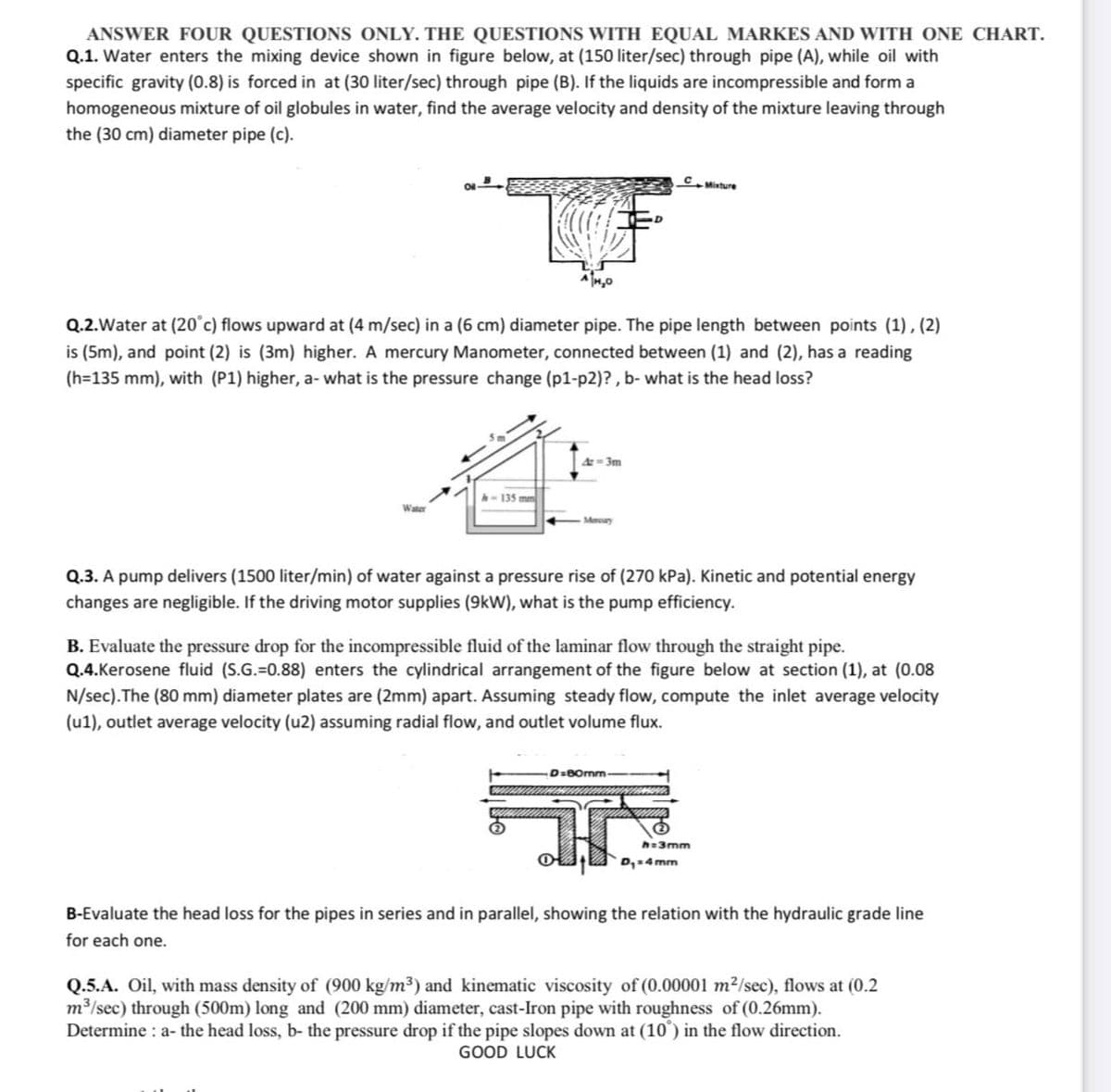homogeneous mixture of oil globules in water, find the average velocity and density of the mixture leaving through the (30 cm) diameter pipe (c).
homogeneous mixture of oil globules in water, find the average velocity and density of the mixture leaving through the (30 cm) diameter pipe (c).
Chapter2: Loads On Structures
Section: Chapter Questions
Problem 1P
Related questions
Question

Transcribed Image Text:ANSWER FOUR QUESTIONS ONLY. THE QUESTIONS WITH EQUAL MARKES AND WITH ONE CHART.
Q.1. Water enters the mixing device shown in figure below, at (150 liter/sec) through pipe (A), while oil with
specific gravity (0.8) is forced in at (30 liter/sec) through pipe (B). If the liquids are incompressible and form a
homogeneous mixture of oil globules in water, find the average velocity and density of the mixture leaving through
the (30 cm) diameter pipe (c).
CMixture
Q.2.Water at (20°c) flows upward at (4 m/sec) in a (6 cm) diameter pipe. The pipe length between points (1), (2)
is (5m), and point (2) is (3m) higher. A mercury Manometer, connected between (1) and (2), has a reading
(h=135 mm), with (P1) higher, a- what is the pressure change (p1-p2)?, b- what is the head loss?
= 3m
h- 135 mm
Water
Mury
Q.3. A pump delivers (1500 liter/min) of water against a pressure rise of (270 kPa). Kinetic and potential energy
changes are negligible. If the driving motor supplies (9kW), what is the pump efficiency.
B. Evaluate the pressure drop for the incompressible fluid of the laminar flow through the straight pipe.
Q.4.Kerosene fluid (S.G.=0.88) enters the cylindrical arrangement of the figure below at section (1), at (0.08
N/sec).The (80 mm) diameter plates are (2mm) apart. Assuming steady flow, compute the inlet average velocity
(u1), outlet average velocity (u2) assuming radial flow, and outlet volume flux.
D:BOrmm
h=3mm
D,4 mm
B-Evaluate the head loss for the pipes in series and in parallel, showing the relation with the hydraulic grade line
for each one.
Q.5.A. Oil, with mass density of (900 kg/m3) and kinematic viscosity of (0.00001 m²/sec), flows at (0.2
m /sec) through (500m) long and (200 mm) diameter, cast-Iron pipe with roughness of (0.26mm).
Determine : a- the head loss, b- the pressure drop if the pipe slopes down at (10°) in the flow direction.
GOOD LUCK
Expert Solution
This question has been solved!
Explore an expertly crafted, step-by-step solution for a thorough understanding of key concepts.
Step by step
Solved in 2 steps with 2 images

Knowledge Booster
Learn more about
Need a deep-dive on the concept behind this application? Look no further. Learn more about this topic, civil-engineering and related others by exploring similar questions and additional content below.Recommended textbooks for you


Structural Analysis (10th Edition)
Civil Engineering
ISBN:
9780134610672
Author:
Russell C. Hibbeler
Publisher:
PEARSON

Principles of Foundation Engineering (MindTap Cou…
Civil Engineering
ISBN:
9781337705028
Author:
Braja M. Das, Nagaratnam Sivakugan
Publisher:
Cengage Learning


Structural Analysis (10th Edition)
Civil Engineering
ISBN:
9780134610672
Author:
Russell C. Hibbeler
Publisher:
PEARSON

Principles of Foundation Engineering (MindTap Cou…
Civil Engineering
ISBN:
9781337705028
Author:
Braja M. Das, Nagaratnam Sivakugan
Publisher:
Cengage Learning

Fundamentals of Structural Analysis
Civil Engineering
ISBN:
9780073398006
Author:
Kenneth M. Leet Emeritus, Chia-Ming Uang, Joel Lanning
Publisher:
McGraw-Hill Education


Traffic and Highway Engineering
Civil Engineering
ISBN:
9781305156241
Author:
Garber, Nicholas J.
Publisher:
Cengage Learning